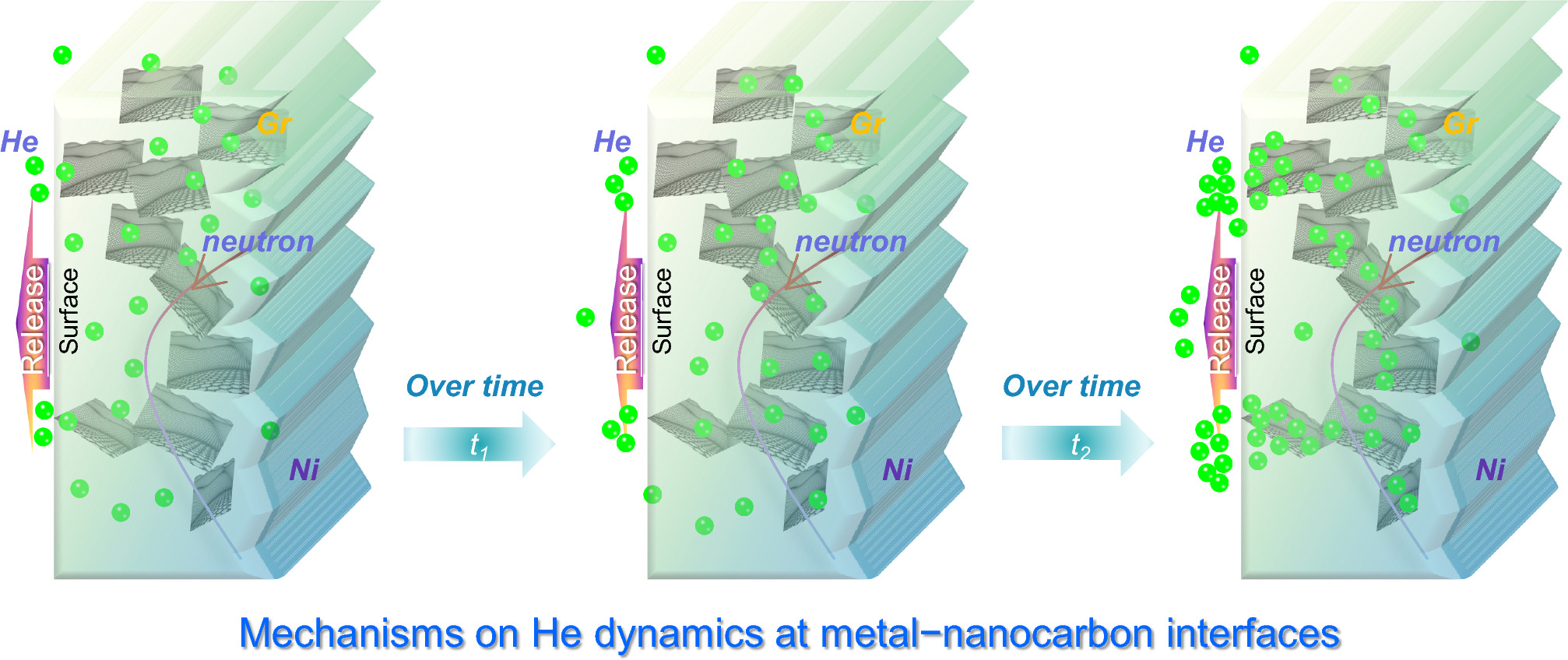https://doi.org/10.1140/epjp/s13360-025-06447-1
Regular Article
Atomistic studies of helium trapping and diffusion at Ni–graphene interfaces
1
Key Laboratory of Material Physics, Ministry of Education, School of Physics, Zhengzhou University, 450001, Zhengzhou, China
2
International Joint Laboratory for Integrated Circuits Design and Application, Ministry of Education, School of Physics, Zhengzhou University, 450001, Zhengzhou, China
3
State Key Laboratory of Nonlinear Mechanics, Institute of Mechanics, Chinese Academy of Sciences, 100190, Beijing, China
Received:
31
December
2024
Accepted:
17
May
2025
Published online:
6
June
2025
The use of metal–nanocarbon interfaces to prevent the bubble-to-void transition has emerged as a novel approach for developing materials resistant to helium (He) embrittlement. However, many critical mechanisms governing He dynamics near these interfaces remain inadequately understood. Here we employed the Ni−graphene interface (NGI) as a model system to investigate He trapping and diffusion through atomistic simulations (300–1,200 K). Key findings demonstrate rapid He trapping at NGIs, with anisotropic in-plane diffusion (![$$ \left[ {\bar{1}10} \right] $$](/articles/epjplus/abs/2025/06/13360_2025_Article_6447/13360_2025_Article_6447_tex_eq1.png) ,
, ![$$ \left[ {\bar{1}\bar{1}2} \right] $$](/articles/epjplus/abs/2025/06/13360_2025_Article_6447/13360_2025_Article_6447_tex_eq165.png) ) exhibiting a tenfold higher diffusivity (prefactor: 6.251 × 10–2 nm2⋅ps−1) and lower activation energy (0.057 eV) than pure Ni. Above 600 K, interfacial capture dominates, minimizing bulk residence. Unlike hydrogen, which forms stable C–H bonds, He migrates freely along NGIs without chemical interaction, promoting release. NGIs could suppress 3D bubble growth by redirecting He into planar pathways, aligning with observed bubble size reduction. The work contrasts He dynamics at NGIs versus grain boundaries, highlighting the superior capacity of metal–nanocarbon interfaces for He venting. These insights provide a mechanistic basis for designing helium-resistant composites, advancing strategies to mitigate embrittlement through controlled helium transport.
) exhibiting a tenfold higher diffusivity (prefactor: 6.251 × 10–2 nm2⋅ps−1) and lower activation energy (0.057 eV) than pure Ni. Above 600 K, interfacial capture dominates, minimizing bulk residence. Unlike hydrogen, which forms stable C–H bonds, He migrates freely along NGIs without chemical interaction, promoting release. NGIs could suppress 3D bubble growth by redirecting He into planar pathways, aligning with observed bubble size reduction. The work contrasts He dynamics at NGIs versus grain boundaries, highlighting the superior capacity of metal–nanocarbon interfaces for He venting. These insights provide a mechanistic basis for designing helium-resistant composites, advancing strategies to mitigate embrittlement through controlled helium transport.
Copyright comment Springer Nature or its licensor (e.g. a society or other partner) holds exclusive rights to this article under a publishing agreement with the author(s) or other rightsholder(s); author self-archiving of the accepted manuscript version of this article is solely governed by the terms of such publishing agreement and applicable law.
© The Author(s), under exclusive licence to Società Italiana di Fisica and Springer-Verlag GmbH Germany, part of Springer Nature 2025
Springer Nature or its licensor (e.g. a society or other partner) holds exclusive rights to this article under a publishing agreement with the author(s) or other rightsholder(s); author self-archiving of the accepted manuscript version of this article is solely governed by the terms of such publishing agreement and applicable law.





